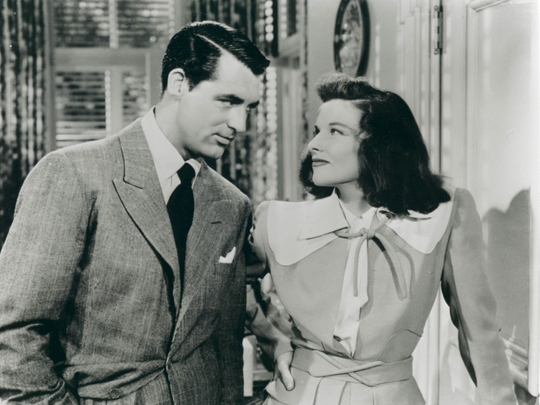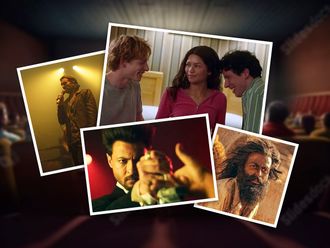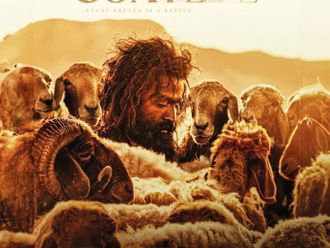
Cary Grant, Hollywood’s most dry and dapper gentleman, was full of secrets. Even now, when we can easily read all about his adventures — the five wives, the gay relationships, the rows with the Academy, the chemical experimentation — it’s a surprise to learn that Hitchcock’s stiff-necked hero was more of a bad boy than a sweetheart.
That’s because his smooth appearance on screen is a seductive path to an idea of old-school movie charm, the twinkly-eyed gent in a dress shirt we’d like to clink martinis with. But deep down, the real appeal of Cary Grant is that we know he’s not as conventional or as saccharine as that at all.
Over 10 days, the Cary Grant festival in Bristol celebrates the city’s most elegant son. The event is billed as “Cary comes home for the weekend”, and there will be screenings of some of his most famous films, in settings that resonate with the themes of the films or that were special to Grant.
Notorious (1946), the Hitchcock thriller co-starring Ingrid Bergman, will be shown in a wine cellar, while Bringing Up Baby (1938), in which Grant plays a palaeontologist, will screen at Bristol City Museum. The festival will remember another local legend by showing the classic weepie An Affair to Remember (1957), in which Grant plays opposite fellow Bristolian Deborah Kerr.
By feting the man once known as Archie Leach in his own hometown, the festival also offers a chance to look into the background of this unusual movie star. There’s no reason why a boy from Bristol should not become the urbane and sharply dressed epitome of Hollywood glamour, but the route he took was circuitous. And where exactly does that distinctive, strangulated accent come from?
Meeting Chaplin
Born in Bristol on 18 January 1904, the young Archie would visit the music hall with his father. On one of those trips, in 1909, he first saw his idol Charlie Chaplin on stage with the Fred Karno troupe. Archie was enchanted, and, as he followed Chaplin’s career, the more he liked the idea of performing, of travelling to America and working in the movies. His first job in the theatre was as a teenager, operating the stage lights at the Bristol Hippodrome, which further convinced him that he wanted to tread the boards.
Like Chaplin, he started out on the variety stage, doing acrobatics and comedy acts — very far from being a leading man. He was a fine physical comedian, especially good at taking a fall, tumbling and walking on stilts. You can see that boisterous slapstick on display in his films, especially the screwball comedies of the 1930s such as the sublime The Awful Truth (1937) or Bringing Up Baby.
There was one comic trick he couldn’t master, however: he could not shift his West Country burr, and put on the “toff” accent required for many skits.
Leach’s life became more glamorous in 1920 when the troupe he was part of travelled to the US — to appear on Broadway. Leach found crossing the Atlantic exciting: he had often watched the boats in Bristol harbour as a boy, and dreamed of escape and show business. The trip became even more fun for the teenager when he realised that Douglas Fairbanks and Mary Pickford were on board. Leach ended up making pals with the couple (“The first films stars I ever met”) and even did exercises with Fairbanks on deck.
The Broadway gig came to an end in 1922, and Leach, alone in New York, was on his uppers. Then followed one of the strangest periods of a strange life. He made ends meet by working as a stilt-walker in Coney Island during the day, and as an escort in the swankiest New York nightclubs and parties in the evenings. It was while carrying out his night job that Leach further practised his posh English accent on the matrons of Manhattan, resulting in the nasal, not nearly plummy enough, clipped accent now familiar from his films. But, with his new stiff-backed posture, a crisp tuxedo and a cute, distinctive British accent, he played the smoothie to perfection — an act he would repeat on the sound stage, playing debonair heroes for Hitchcock and Hawks.
The right connections and a fallout
At this time he was sharing a flat in Greenwich Village with costume designer Orry-Kelly, from whom he may also have picked up some of his camp on-screen mannerisms. The two were close, but then had a massive, very public falling out. Grant doesn’t mention Orry-Kelly in his autobiography, but the designer lambasts the actor as stingy and self-centred in his own memoir. Nevertheless, it was Orry-Kelly who made the right introductions to get Leach an audition for his first Broadway musical, paving the way for him to appear as a leading man and to catch the eye of Hollywood scouts.
Orry-Kelly went to LA to work as a studio designer and Leach followed, arriving in Hollywood in 1932. Leach signed with Paramount that year, but not before changing his name to the more American-sounding Cary Grant, at the suggestion of studio executive BP Schulberg. With that, the movie career that would make his name began, as did the dual identity that troubled him. “Everybody wants to be Cary Grant,” he said. “Even I want to be Cary Grant.”
His first roles were in pre-code films, including She Done Him Wrong (1933), with Mae West. His star rose as he specialised in light comedies, from Topper (1937) to The Philadelphia Story (1940), which exploited his acrobatic skills and timing, as well as his buttoned-up English persona and his hint of camp.
Only Angels Have Wings (1939) gave Grant the chance to play a more grizzled character, almost an action hero, and a year later in 1940, he played the first of four roles for Hitchcock, in Suspicion with Joan Fontaine.
The rebel
All the time that Grant was one of Hollywood’s biggest stars, he was also one of the system’s biggest rebels, forever the naughty boy who was expelled from school aged 15. He didn’t play by the rules of the studio system and refused to join the Academy, damaging his chances of winning an Oscar (he was nominated twice but didn’t win until he was given an honorary award in 1970). He lived with actor Randolph Scott for 11 years, a relationship many interpreted as romantic, which lost him some influential friends and film roles. And, while rumours of bisexuality swirled around him (he also liked to drag up at costume parties),
Grant married five times, having a daughter with his fourth wife, Dyan Cannon, when he was in his 60s. As well as a colourful love life, he was fond of taking LSD as part of his psychotherapy, a practice he continued to advocate until his death. As Grant got older, his British roots reasserted themselves. When his career slowed down in the mid-50s, Hitchcock continued to have faith and cast him in To Catch a Thief (1955) and North By Northwest (1959), reinventing him as a suave, older man of mystery. In the 60s, there was even talk of Grant playing James Bond.
Archie Leach the Bristol boy had lived out his Chaplin fantasy and become Cary Grant the movie star. Or, as he put it: “I pretended to be somebody I wanted to be until finally I became that person. Or he became me.”
The Cary Grant festival, Bristol, runs until 17 July.













